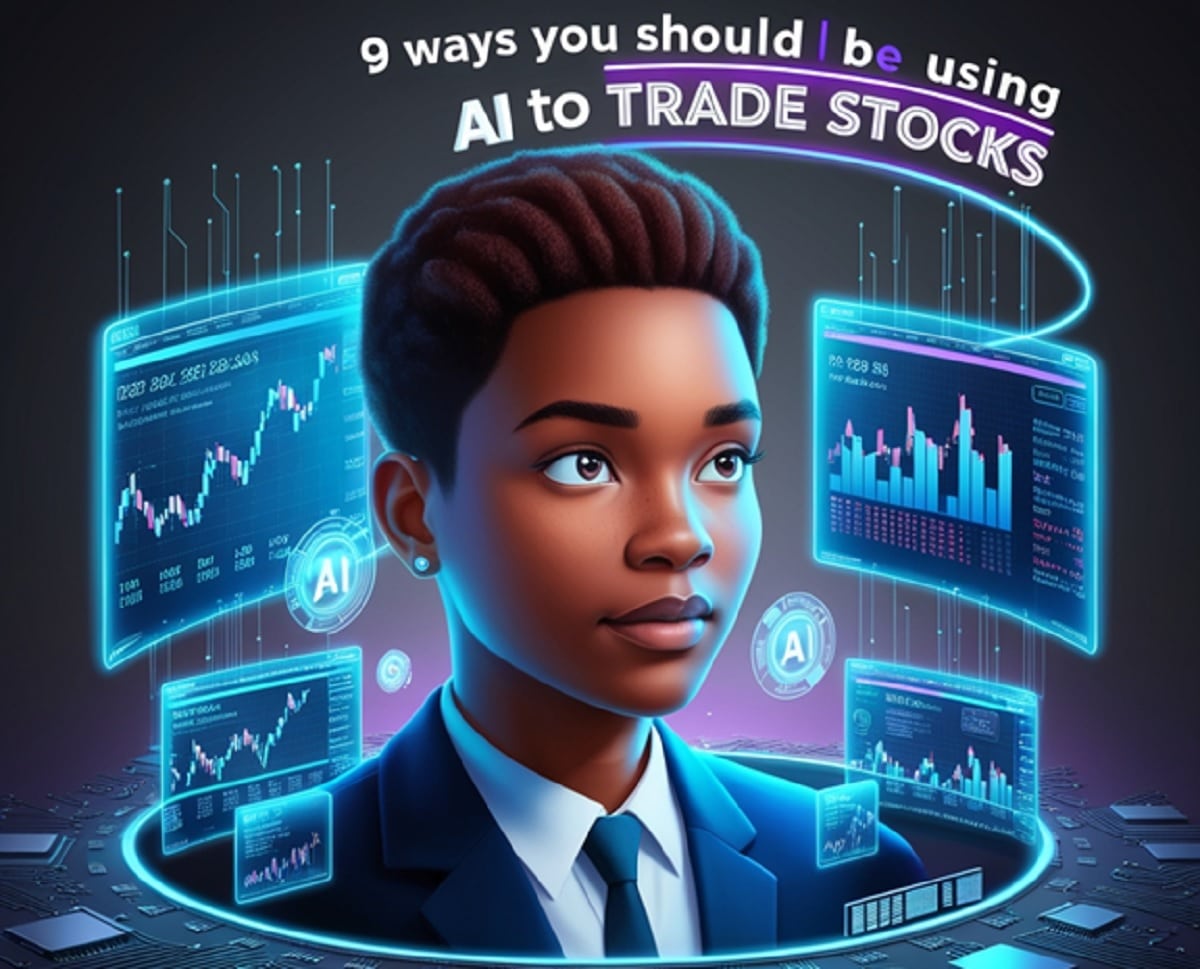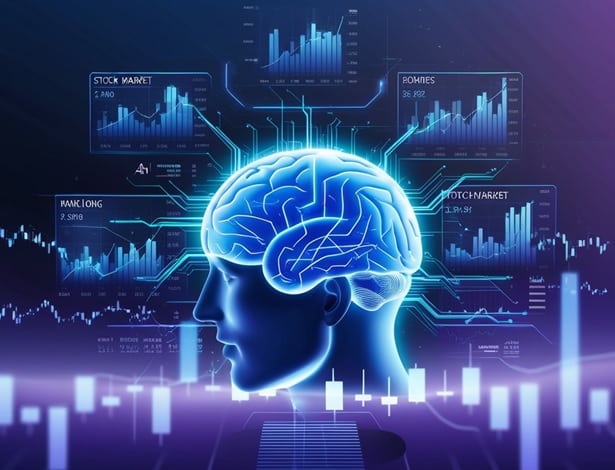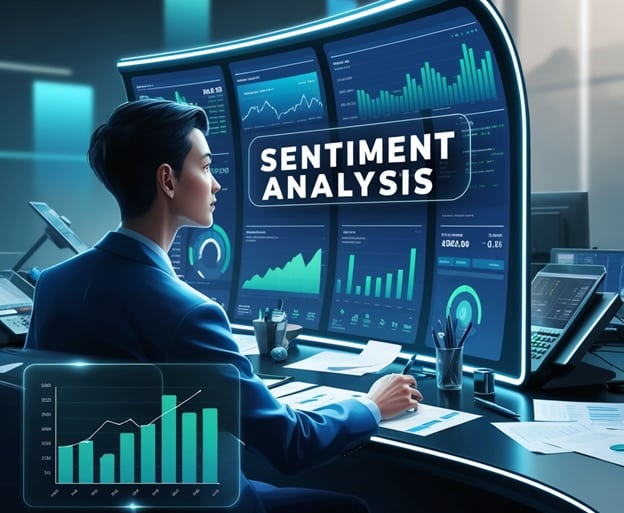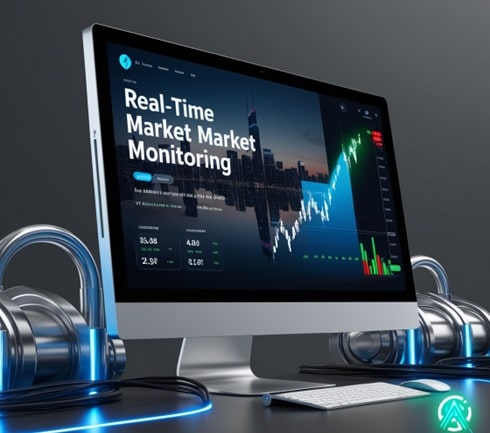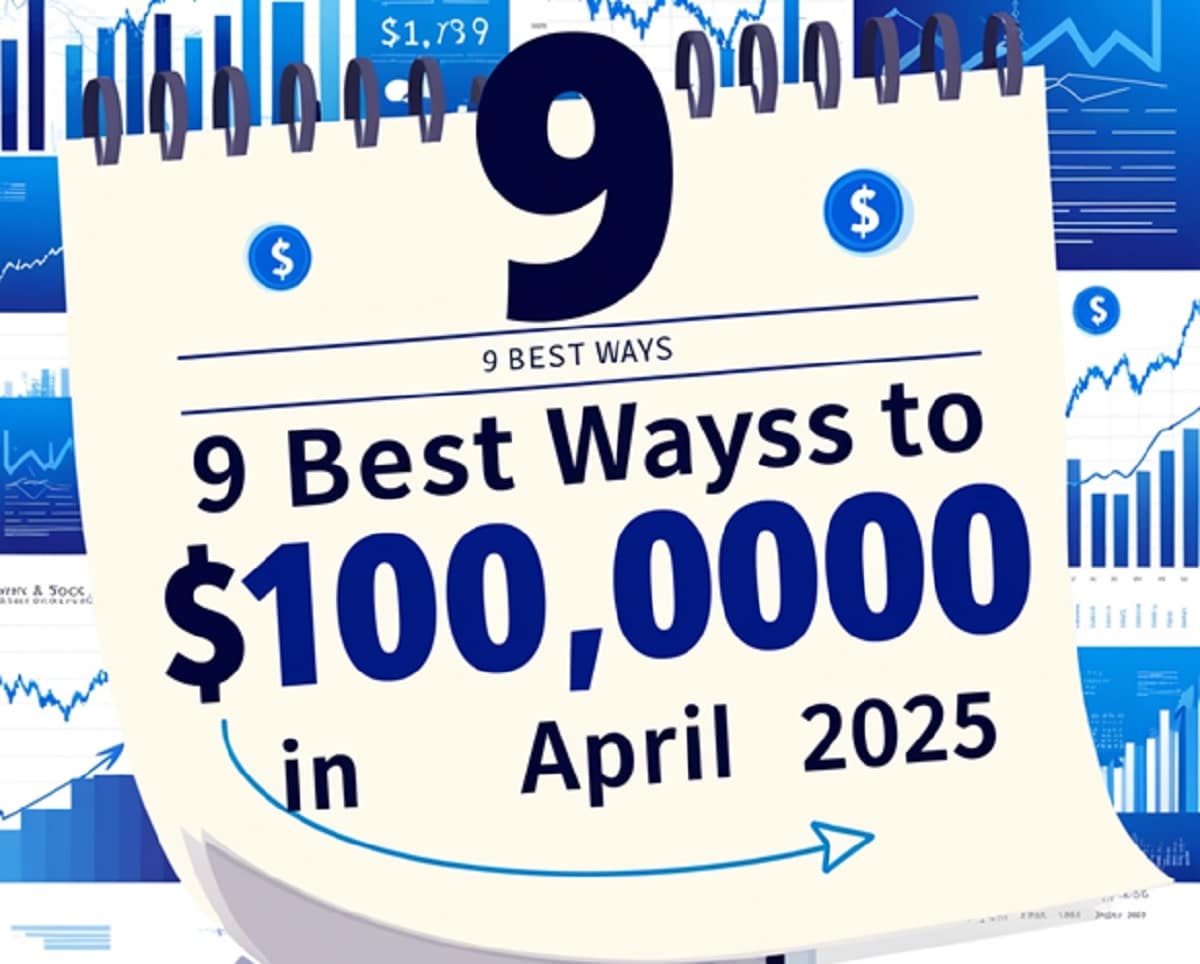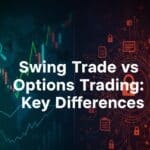Involving stock decision making during market volatility poses difficulties because you need AI assistance. Master AI trading for stocks and find nine effective methods that will improve your trading precision and speed and substantially increase your earnings.
Introduction
In today’s fast-paced financial markets, traders and investors are constantly searching for ways to gain an edge. Modern stock trading methods that were successful for decades are no longer effective since both market conditions and trading resources have experienced fundamental shifts. With the rise of technology, Artificial Intelligence (AI) has emerged as a game-changer in stock trading.
The Role of AI in Stock Trading
The stock trading industry experiences profound changes through artificial intelligence tools that give traders highly complex analytical systems for market forecast and trade implementation along with risk governance functions. Stock trading through traditional methods usually depends on humans to use their instincts supported by history-based analyses from previous experience. In contrast, AI systems can process vast amounts of real-time data, learn from patterns, and make decisions in milliseconds offering a significant advantage.
The Problem: Traditional Trading Limitations
Despite the obvious advancements, many traders still rely on outdated methods such as gut feelings, news-based trading, and simple technical indicators. This can lead to missed opportunities, slow reactions in volatile markets, and less-than-ideal trade outcomes. The current trading environment surpasses most traders’ ability to keep pace resulting in their continuous struggle to adapt to the ongoing market evolution.
AI: The Solution to Traditional Trading Problems
AI enables stock investors to profit from sophisticated algorithms and machine learning models which process massive historical data for more accurate forecasts beyond human capabilities. AI-driven tools can automate trade decisions, assess risk in real-time, and even optimize trading strategies for improved performance.
The following guide provides nine strategic methods AI enables stock trading that shows its ability to bypass conventional trading barriers and maximize trading efficiency and profitability.
Understanding AI and Stock Trading
Before exploring AI’s stock trading applications it is crucial to distinguish its definition from its trading world usage. Machines, particularly computer systems, perform simulations of human cognitive capabilities as defined by AI protocol. Stock trading systems make use of AI to process market information for prediction purposes and implement trade management by means of numerical models and statistical patterns.
How AI Differs from Traditional Trading Methods
Traditional trading practices depend on people’s judgments together with their technical abilities and simple indicators. Human traders perform chart examination as well as fundamental research while tracking economic updates in an attempt to forecast market price activities. The methods are proven successful yet they suffer from important shortfalls especially in data volume processing and real-time reaction efficiency.
AI possesses several essential benefits which it contributes to markets.
- Speed and Efficiency: Economical and rapid data processing and trend analysis through AI happens at such speed that surpasses the capabilities of human traders.
- Data-Driven Decisions: AI algorithms function through processing data patterns combined with statistical models and past trading history and thus avoid impulsive human-based trading decisions while human traders make emotional decisions.
- Adaptability: Machine learning which is a form of artificial intelligence allows algorithms to enhance their operation through continual learning thus optimizing trading operations.
Types of AI Used in Trading
- Machine Learning (ML): Although system operation is autonomous, machine learning algorithms learn from past data then develop improved forecasting capabilities automatically. With these algorithms stock price analysis and trading volume evaluation and economic indicator analysis enable identification of patterns which lead to the generation of future price movement predictions.
- Natural Language Processing (NLP): Through NLP AI achieves the ability to process human language thus enabling analysis of news articles combined with earnings reports as well as social media sentiment and financial statements for market sentiment analysis.
- Deep Learning: The subset of machine learning imitates neural networks from human brains to produce advanced predictions which mostly appear in high-frequency trading (HFT) operations..
- Reinforcement Learning: Through this AI method algorithms make adjustments to their actions after receiving feedback from previous outcome results.
Real-World Example of AI in Stock Trading
The analysis of stock market trends by AI-powered trading robots continues uninterrupted during all hours of the day as these bots automatically execute transactions based on stock market patterns. The bots apply machine learning technology to enhance their trading capacity through each transaction which develops more efficient approaches for better earnings.
The essential nature of AI as a base in stock trading enables investors to perceive its speed and data analysis capabilities as well as pattern recognition and adaptability to recognize its usefulness in contemporary financial markets.
AI-Powered Predictive Analytics for Market Trends
Stock trading experiences a powerful AI application because AI can predict market trends with high predictive capabilities. The AI subfield predictive analytics employs statistical approaches and machine learning algorithms to study past market records in order to locate patterns which suggest upcoming market patterns. The stock market presents AI with vast data comprising historical prices and trading volumes together with macroeconomic elements which enable the tool to create reliable short-term and long-term market trend forecasts.
Predominant predictive analytics tools generated by AI technology enable traders to forecast market price fluctuations together with volatility patterns and breaking points that might occur within the market. Ology outpaces traditional evaluation tools because it analyzes multiple variables at the same time which produces accurate and dependable predictions beyond human intuition or simple technical indicators. AI tools that assess real-time market data alter their predictions instantly so traders always receive the latest market trends.
The performance of a stock over the next several weeks and days can be predicted by time series analysis which runs on AI algorithms based on stock price historical records. Machine learning models grow more accurate through time because they progressively process additional data available to them. Using AI allows traders to detect market trends which the human brain cannot observe directly enabling them to detect potential lucrative trading options.
Companies can use artificial intelligence systems to assess stock market activities through online social media sentiment which provides future price movement predictions as a practical predictive analytics application. AI evaluates public sentiment shifts concerning specific stocks by measuring both the tone and quantity of conversations on these stocks. The rapid identification of oscillating sentiment enables investors to modify their trading positions before market forces start affecting the stock prices.
The prediction of market trends through AI technology helps traders make better trades and lets their portfolio perform at peak levels by achieving maximum returns with decreased risks. AI-powered predictive analytics make traders independent of speculation since their choices rely on data-led market trend forecasts.
Automating Trade Execution with AI
The most vital benefit of AI in stock trading is its power to handle complete trade execution operations automatically. AI systems conduct trading operations through predefined parameters which include evaluating market behavior as well as price data and critical market factors before performing computerized trade execution. The automated system reduces traders’ need to check markets continuously thus freeing up their schedule while trade executions occur at the peak timing.
The automation benefits fast markets because price changes often occur rapidly and automatically. An AI system performs automatic decisions so quickly that it executes trades at speeds much faster than human traders need several seconds to minutes for similar operations.
AI-driven automation removes emotional trading from the equation thus solving one of the fundamental challenges that arises from human methods. Emotions rooted in both fear and greed typically influence human traders to make spontaneous investments that damage their trading results. The sole basis for AI decision making stems from data that enables trading through analytical and logical systems instead of emotional responses. The strategy produces stable trading patterns because it teaches traders to follow specific rules which ultimately creates long-term trading excellence.
The automated trading systems implemented through algorithmic trading demonstrate how AI runs programmed algorithms which perform trades under price limits and technical parameters and market psychological values. Specialized software keeps operating 24/7 while its built-in algorithms detect optimal market conditions to execute automatic trades. By implementing algorithmic trading any trader can capture market opportunities that appear automatically throughout the continuous market fluctuations.
AI automation of trade execution enables traders to reach improved operational efficiency as well as reach maximum profit potential. The rapid market adaptation combined with unbiased decision-making allows traders to develop superior trading approaches which produce better long-term results.
AI for Risk Management in Trading
Successful traders need AI-powered risk management because it represents a vital element for managing and reducing potential risks during trading activities. Effective control of stock market risk assessment defines the path between making sustainable profits and facing serious financial losses in trading activities. AI technology improves risk management through time-sensitive data examination together with threat recognition and instantaneous method adjustments.
Tools based on artificial intelligence technology process market conditions together with historical data to determine trade-specific risk levels as well as risks related to entire portfolio performance. AI uses volatility parameters alongside market trends and historical loss data to create exact risk assessments which provide traders with efficient strategies to modify their position. The system implements AI capabilities to establish stop-loss orders according to market volatility showing time which protects traders from market declines. The real-time risk adjustment capabilities work to stop extensive financial losses which could appear because of delayed human action or mistakes.
By analyzing asset sectors the technology can spot connected trends which traders use to develop strategically diversified portfolios that divide risks among multiple investments. The analysis of stock-to-stock and stock-commodity stock-currency and other asset interrelations enables AI systems to create portfolios which reduce risks stemming from individual asset classes. Such intelligent allocation of risk helps traders protect their individual trades while safeguarding their portfolio from overall risks.
The system applies AI algorithms for market volatility assessment so it can provide risk-mitigation strategies to traders. The system can help traders whose stock resides in a declining sector to switch their assets while simultaneously using hedging strategies by acquiring stocks from growing sectors. The risk management strategy based on proactive measures remains crucial during unpredictable markets because emotions and scarce information tend to affect human judgment.
The incorporation of AI in risk management strategies enables traders to establish better investment control and get improved accuracy and forecasting power. The automated assessment of risks coupled with immediate data-driven choices in trading supports traders to stay objective and protect fund assets while minimizing emotional response to market volatility.
AI for Sentiment Analysis in Trading
Stock trading prices heavily rely on existing market sentiments because the fast-paced industry strongly responds to these feelings. Market sentiment assessments by traders since previous times relied heavily on economic reports with news articles and social media discussions which possess subjective elements and human-related errors. The automated analysis of enormous unstructured data through AI enables sentiment analysis at a superior level for stock market sentiment detection.
The analysis process uses AI tools which extract sentiment data from different data sources ranging from financial news outlets to Twitter along with Reddit and blogs and also includes earnings reports. NLP methods enable these tools to understand the linguistic tone and emotional context expressed in their analyzed sources. AI systems generate important market insights about individual stocks and complete sectors by determining if the market sentiment is positive, negative or neutral.
Social media posts about specified companies are analyzed through AI systems which detect rising or falling public sentiment in those companies. AI systems identify rising positive sentiment as a sign to buy stock while detection of negative sentiment suggests stock values might decrease. These analytical tools provide crucial information about investor attitudes that never seems to move markets such as product launches and earnings reports or CEO statements.
Through AI-based sentiment analysis traders perform data-centered decisions instead of taking directionless decisions with emotions and distortions. AI systems identify changes in market sentiment which prove to be significant before such shifts manifest as price movements in the stock market. The underlying anxiety about a company’s future performance is a possible risk that AI technology can recognize beforehand which enables traders to alter their investment positions accordingly. Positive market sentiment trends detected by AI allow investors to enter trades early since the broader market has not yet reacted to those developments.
The immediate delivery of AI sentiment analysis gives traders the ability to make swift responses that precede market price changes. AI-based strategic advantages enable traders to create better market-time decisions thus optimizing their trading framework in responsive market scenarios.
AI for Portfolio Optimization
The essential element of trading involves portfolio optimization which choose assets strategically to reach maximum profits and lowest possible risks. AI stands essential in this process because it examines various market data to give traders personalized investment advice which matches their individual risk tolerance along with financial goals and present market situations. Using artificial intelligence for portfolio optimization enables the assessment of numerous investment option sets which results in locating the optimal distribution of assets for each defined risk threshold.
AI works as an effective tool for portfolio optimization because it shows exceptional capability in rapid data processing abilities. AI surpasses traditional portfolio optimization methods since it integrates up-to-date market information alongside worldwide economic indicators and alternative data from news media and social platforms. Through this ability AI generates better investment choices and it automatically readjusts investor portfolios according to market factor changes and preserves alignment with trader objectives.
The analysis capabilities of AI enable traders to discover different assets that have no connection with each other thus enabling portfolio diversification. Virtual intelligence algorithms excel at discovering risk-spreading possibilities across multiple assets between various business sectors and international markets which serves as an effective risk reduction method. Traders with concentrated positions in one sector may use AI to analyze opportunities in unrelated industries where specific risks caused by political instability and commodity market shifts remain low.
The portfolio rebalancing process can be completely automated using AI tools because these tools enable traders to modify asset weights to maintain their planned risk-return levels. The portfolio achieves optimal performance along with risk management because AI conducts automatic rebalancing of assets according to market volatility. The approach proves valuable specifically during market volatility when different assets experience quick value changes.
The application of artificial intelligence for strategic portfolio optimization enables traders to develop more data-based decisions that generate better outcomes in their trading activities. Real-time portfolio modification and continuous optimization through AI gives traders an advantage that makes them successful competitors within stock markets which constantly transform.
AI for Backtesting Trading Strategies
Stock trading requires backtesting as a fundamental process for traders to analyze strategy effectiveness through historical data previous to implementation in active trading markets. The advancement of AI has changed backtesting by implementing automation and making it both precise and extremely efficient and time-saving. AI performs backtesting more efficiently than traditional methods because it processes extensive datasets and executes simulations at a much higher speed.
Artificial intelligence backtesting platforms assist traders through evaluating trading methodologies using different market situations along with periods of time and asset clusters. AI uses considerable historical information to generate precise performance predictions about strategic outcomes across multiple existing conditions. The exceptional benefits of backtesting through AI eliminate the requirement for actual capital contributions because traders gain better understanding of their strategy performance. AI continuously updates and optimizes trading strategies through new data feed-ins thereby keeping them appropriate for market condition alterations.
AI provides an essential advantage for backtesting that makes it capable of handling multiple variables beyond traditional testing methods. AI systems evaluate market influencers that include economic data along with social network opinions and political world developments. The inclusion of multiple elements into backtesting models through AI generates simulated scenarios with higher accuracy along with better understanding of real-world performance scenarios.
The identification of patterns together with relationships in historical data by AI systems remains beyond the detection capabilities of most human traders. Using machine learning systems allows businesses to examine enormous databases to identify previously unseen market relationships which can help build better trading choices. The discovery of subtle patterns provides trading strategies with a strong capability for generating better accuracy and revenue potential.
Addition of artificial intelligence to backtesting analysis helps traders work more efficiently and makes their trading methods more effective at reaching market success. AI-backed backtesting enables traders to make their strategies more efficient through continuous optimization because they adjust them using present performance analytics.
AI for Real-Time Market Monitoring and Alerts
When traders need to monitor speedily developing market conditions they depend on real-time market monitoring. The real-time market analytics delivered by artificial intelligence systems help traders prevent losses through instant notifications about price movements and essential market occurrences. A continuous automated review of enormous market information databases allows these AI systems to find stock-related trends and price movements and market news events.
AI real-time monitoring systems are most valuable for their capability to observe multiple market conditions at once. AI conducts continuous observation of stock price fluctuations together with global economic indices and newsfeeds and social media sentiments and additional market-related factors. From this traders gain an entire market perspective during any time frame while handling the massive amount of market information. AI tools remove unimportant data through filtering to display only essential information thereby operating two useful functions: time-saving and critical-event-focused monitoring for traders.
Real-time monitoring gets improved by AI-enabled notifications that function as a primary feature. Online traders can create alert triggers through precise market conditions including price level boundaries and sudden changes in trading volume and essential news releases. The AI system instantly alerts traders as soon as conditions match minimum triggers that the trader established ahead of time. A trader using AI-based alerts receives automatic notifications about stocks that reach their set price targets or reports involving earnings information to help them seize time-sensitive business opportunities.
Historical market data analysis through AI systems enables users to identify market movements which will occur before the actual event takes place. AI analyzes real-time data to establish correlations that help traders predict changing price trends and volatility patterns. The predictive capabilities equipped to traders help them establish better trading decisions because they anticipate market developments.
AI systems that conduct real-time market monitoring through auto-alerts enable stock traders to stay aggressively involved in their trading practice. Traders depend on AI for both accurate intelligence and punctual alerts which lead them to execute quicker decisions while remaining confident about their choices.
The Future of AI in Stock Trading
The advancements in artificial intelligence will drastically deepen its effects on stock trading operations. Predictive models will become more accurate while real-time analytics processing speeds will increase as integration connects to additional alternative data sources such as IoT-generated data and satellite imagery. Through these emerging technologies traders can receive instantaneous market trend intelligence and worldwide economic developments prior to increasing visibility in traditional market outlets.
The most remarkable upcoming development is reinforcement learning which enables AI systems to enhance themselves by means of testing and correction. The ability of this learning system allows for instant adjustments of trading methods that produce smarter reactions to market transformations which also boost profitability. AI will deliver enhanced customization because it will develop trading plans that match exclusive requirements of each individual trader including their particular risk habits and financial priorities.
AI accessibility creates an environment where retail and institutional trading abilities will merge into a single operational space. Simpler investors will obtain high-tech trading tools previously available only to hedge funds and major institutions. AI-driven trading democratization creates equal opportunities between traders so every trader must now accept its new trading dynamics. The decision to disregard AI during this upcoming period will result in market performance decline because the marketplace is moving at unprecedented speed.
Conclusion
The stock trading industry received revolutionary changes through AI surpassing all previous developments of the last ten years. AI offers decision-support systems through predictive modeling as well as live data analysis and portfolio optimization and sentiment analysis to boost trading performance. The nine AI techniques from automated trading to sentiment market assessment analysis show how beneficial proper AI usage can be in stock operations.
The change is necessary because your current human-operated trading system using traditional methods now requires modernization. The implementation of artificial intelligence helps traders extract market intelligence that facilitates seizing opportunities while handling risks subsequently preserving their market position against competitors in high-volume markets. Use investigation of AI stock trading methods to obtain superior trading skills which will outpace competitors who lack AI knowledge.
Frequently Asked Questions About AI in Stock Trading
What is AI in stock trading, and how does it differ from traditional trading methods?
AI in stock trading refers to the use of artificial intelligence tools, such as machine learning, natural language processing, and deep learning, to analyze market data, predict trends, and execute trades. Unlike traditional trading, which relies on human judgment, technical indicators, and manual analysis, AI processes vast amounts of data in real-time, makes data-driven decisions, and adapts to market changes with greater speed and accuracy.
How does AI improve trading precision and speed?
AI enhances trading precision by analyzing historical and real-time data to identify patterns and predict market trends with high accuracy. It improves speed by processing data and executing trades in milliseconds, far surpassing human capabilities, which is critical in fast-paced, volatile markets.
What are the main types of AI used in stock trading?
The main types of AI in stock trading include:
- Machine Learning (ML): Learns from historical data to predict stock price movements and trading patterns.
- Natural Language Processing (NLP): Analyzes news, social media, and earnings reports for market sentiment.
- Deep Learning: Uses neural networks for advanced predictions, often in high-frequency trading.
- Reinforcement Learning: Adjusts trading strategies based on feedback from past outcomes.
How does AI-powered predictive analytics work in stock trading?
AI-powered predictive analytics uses machine learning and statistical models to analyze historical market data, trading volumes, and macroeconomic factors. It identifies patterns to forecast short-term and long-term market trends, enabling traders to make informed decisions based on reliable predictions rather than speculation.
Can AI automate stock trading, and what are the benefits?
Yes, AI can automate trade execution by evaluating market conditions and executing trades based on predefined parameters. Benefits include faster trade execution, reduced emotional bias, consistent trading patterns, and the ability to operate 24/7, capturing opportunities in volatile markets.
How does AI help with risk management in trading?
AI improves risk management by analyzing real-time market data and historical trends to assess trade and portfolio risks. It sets dynamic stop-loss orders, identifies correlated assets for diversification, and provides hedging strategies, helping traders minimize losses and protect their investments.
What is AI-based sentiment analysis, and how does it impact trading?
AI-based sentiment analysis uses natural language processing to evaluate market sentiment from news, social media, and earnings reports. By detecting positive or negative sentiment shifts, AI helps traders anticipate price movements and adjust positions before market reactions occur.
How does AI optimize investment portfolios?
AI optimizes portfolios by analyzing market data, economic indicators, and alternative data to recommend asset allocations that balance risk and return. It identifies uncorrelated assets for diversification, automatically rebalances portfolios based on market changes, and aligns investments with traders’ risk tolerance and goals.
What role does AI play in backtesting trading strategies?
AI enhances backtesting by simulating trading strategies against historical data to evaluate their performance across various market conditions. It processes large datasets quickly, identifies subtle patterns, and optimizes strategies, allowing traders to refine approaches without risking capital.
How does AI support real-time market monitoring and alerts?
AI monitors market conditions, stock prices, news, and social media in real-time, filtering out irrelevant data to provide traders with critical insights. It sends instant alerts based on user-defined triggers, such as price targets or news events, enabling timely trading decisions.
Is AI in stock trading accessible to retail traders?
Yes, AI-driven trading tools are becoming increasingly accessible to retail traders, leveling the playing field with institutional investors. Platforms offering AI-powered analytics, automation, and portfolio optimization are now available, though costs and complexity may vary.
What is the future of AI in stock trading?
The future of AI in stock trading includes more accurate predictive models, faster real-time analytics, and integration with alternative data sources like IoT and satellite imagery. Reinforcement learning will enable smarter, adaptive strategies, and AI democratization will provide retail traders with advanced tools previously exclusive to institutions.
Do I need to understand AI to use it in stock trading?
No, you don’t need to be an AI expert to use AI in stock trading. Many AI-powered platforms are user-friendly, offering intuitive interfaces and pre-built tools. However, understanding basic trading concepts and the specific AI tools you use can help maximize their benefits.
Are there risks to using AI in stock trading?
While AI enhances trading, risks include over-reliance on algorithms, potential technical glitches, and the need for accurate data inputs. Traders should monitor AI systems, maintain human oversight, and ensure strategies align with market conditions to mitigate these risks.
How can I start using AI for stock trading?
To start, research AI-powered trading platforms or tools that suit your needs, such as those offering predictive analytics, automation, or sentiment analysis. Test them with small investments, learn their features, and gradually integrate AI into your trading strategy.

